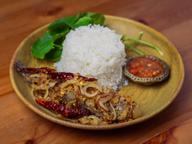Pinongian sada is related to bosou sada, but this recipe does not involve rice. It has a flavour similar to salted fish, with a distinctly earthy kick. Use this recipe to ferment the catch from a good fishing trip, or as a beginner’s project for fermenting fish. Read more about fermenting with pangi.
Pinongian sada
by Pison JaujipPinongian sada is related to bosou sada, but this recipe does not involve rice. It has a flavour similar to salted fish, with a distinctly earthy kick. Use this recipe to ferment the catch from a good fishing trip, or as a beginner’s project for fermenting fish. Read more about fermenting with pangi.
Servings: 12
Prep time: A project
Servings: 12
Prep time: A project
Ingredients
500g freshwater fish, cleaned and scaled (if scaly)
25g salt
50g pangi flesh, finely ground
Directions
- If using large river fish such as larger keli, butterfly the fish. If using smaller fish, they can be kept whole. Pat the fish dry with a paper towel.
- In a large mixing bowl, mix all the ingredients together evenly.
- Lay the fish neatly in clean, airtight container. Label it with the current date.
- Leave the fish to ferment for at least 1 week.
- After 1 week, the fish is ready to be cooked. It can be fried as is, or fried with slices of ginger, shallots, garlic, and chillies. Serve with hot white rice.
Tips
- Pison uses unprocessed pangi, as the pinongian fermentation process will leach the toxins away from the pangi flesh. Processed pangi can be used as well. Here’s our guide on cleaning the fruit.
- Glass containers are preferable, so that the fermentation can be observed without opening the container. Another added benefit is that glass will not absorb scents the way plastic can.
- If there is mould growing on the fish, take note of the colour. If the mould is white, it is not harmful. But if the mould is black, throw out the fish to start over after cleaning the container thoroughly.
- Pison does not recommend using saltwater fish as a substitution, as the flavours will not be same.
Ingredients
500g freshwater fish, cleaned and scaled (if scaly)
25g salt
50g pangi flesh, finely ground
Directions
- If using large river fish such as larger keli, butterfly the fish. If using smaller fish, they can be kept whole. Pat the fish dry with a paper towel.
- In a large mixing bowl, mix all the ingredients together evenly.
- Lay the fish neatly in clean, airtight container. Label it with the current date.
- Leave the fish to ferment for at least 1 week.
- After 1 week, the fish is ready to be cooked. It can be fried as is, or fried with slices of ginger, shallots, garlic, and chillies. Serve with hot white rice.
Tips
- Pison uses unprocessed pangi, as the pinongian fermentation process will leach the toxins away from the pangi flesh. Processed pangi can be used as well. Here’s our guide on cleaning the fruit.
- Glass containers are preferable, so that the fermentation can be observed without opening the container. Another added benefit is that glass will not absorb scents the way plastic can.
- If there is mould growing on the fish, take note of the colour. If the mould is white, it is not harmful. But if the mould is black, throw out the fish to start over after cleaning the container thoroughly.
- Pison does not recommend using saltwater fish as a substitution, as the flavours will not be same.






